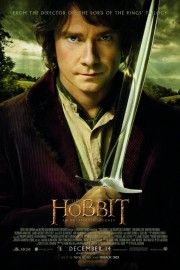The Hobbit: An Unexpected Journey
I’m very grateful that I didn’t see “The Hobbit: An Unexpected Journey” in the controversial 48fps presentation which Peter Jackson prefers. I will see it in that format before it leaves theatres, but because I didn’t have to worry about adjusting my perception of the film’s look to it on the first time out, I could focus instead on the movie itself, and how Jackson and his collaborators have started off their trilogy based of J.R.R. Tolkien’s original, published journey to Middle Earth.
It’s been about a decade since I read “The Hobbit,” when I read it after finishing up “The Lord of the Rings” as Jackson’s trilogy of that novel was being released. I’m not sure if I’m going to read it again before the third film in this new trilogy (“There and Back Again”) hits theatres in the summer of 2014, so I can compare and contrast what Jackson and his screenwriters (Fran Walsh, Philippa Boyens, and Guillermo Del Toro, who was going to direct the films before MGM hit a financial snag) have brought to the story, and justify turning “The Hobbit,” which is 1/3 the size of “Lord of the Rings,” into three films. I’ve already been skeptical of this story being turned into multiple films (let alone THREE)– why do I want to potentially ruin the experience of watching the film with trying to pinpoint where Jackson might have gone wrong?
A little bit of letdown from “The Hobbit” is to be expected. “The Lord of the Rings” trilogy is one of the greatest achievements in movie history, and was one of the most ambitious. It was the culmination of a century of cinematic innovation and epic filmmaking, and pointed the way towards films that have come since, from the “Harry Potter” series to “Avatar” to “The Avengers.” Thankfully, I went through the experience of seeing another franchise take the chance of tarnishing its legacy– after the “Star Wars” prequels, how bad could “The Hobbit” be, especially since it has a literary source?
The answer, for me at least, is not nearly as bad as “The Phantom Menace” was. I will admit to still being skeptical of the decision to do three movies, especially since the 170-minute running time moves in fits and spurts, and the sense of adventure and the unknown of “The Fellowship of the Ring” is gone, especially with the obvious framing device of the elder Bilbo Baggins (Ian Holm) putting the story we’re about to see down on paper. But the film, and the world Jackson and his artists created, is more-than-solid entertainment, and proof that Jackson is still the ideal filmmaker for our adventures in Middle Earth.
The story will already be well-known to Tolkien fans, and possibly to people coming to the material by way of Jackson’s films, but a quick synopsis is easy enough. Sixty years before the events of “Lord of the Rings,” a younger Bilbo (Martin Freeman, lively and entertaining) is recruited from his quiet life in The Shire by Gandalf the Grey (Sir Ian McKellen, returning to the role like he never left) to join a company of dwarfs in traveling to The Lonely Mountain to battle the dragon Smaug, and take back the kingdom of Erebor. The band of 14 is led by Thorin Oakenshield (Richard Armitage), who is skeptical of Bilbo, but will trust Gandalf’s judgement, although Bilbo will have a long way to go to earn Thorin’s trust, especially when orcs and goblins make the road treacherous for all involved.
As I said, the film moves in fits and spurts on a pacing front, but I think that has a lot to do with the scenes and narrative threads Jackson adds to pad the story out to three films. In particular, a trip to Rivendell, and scenes with Galadriel (Cate Blanchett) and Saruman (Christopher Lee), slows the film to a crawl, even if it does add a fascinating subplot to be explored in the next two films; the dinner and dwarf meeting at Bag End, however entertaining, also makes it difficult for the movie to get going, especially after the opening scenes with the older Bilbo that feel somewhat unnecessary.
Thankfully, Jackson has some great moments to come, like when Bilbo and co. are threatened by three trolls looking for a meal, a scene referenced in “Fellowship,” both in the theatrical and extended versions. Best of all is a brilliant adaptation of the “Riddles in the Dark” sequence between Bilbo and Gollum (Andy Serkis, as much a marvel in the role as he was in the “Rings” films), when events take place that will impact the futures of both characters. That scene alone makes the film’s difficult pacing worthwhile, along with scenes of excitement involving Stone Giants; the vile Goblin King; and Radagast the Brown, a wizard who rides a sleigh pulled by rabbits, and becomes aware of pending evil. The production team Jackson has assembled– or rather, re-assembled after their Oscar-winning results on the “Rings” films –brings their best efforts to the film, with the stirring music by Howard Shore and extraordinary makeup and visual effects from WETA Digital standing out as we return to Middle Earth, and by the end, can’t wait to follow Jackson the rest of the way through the next two films.










